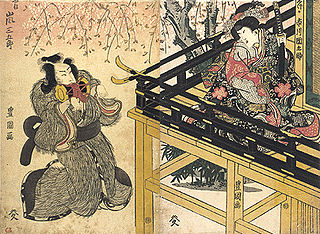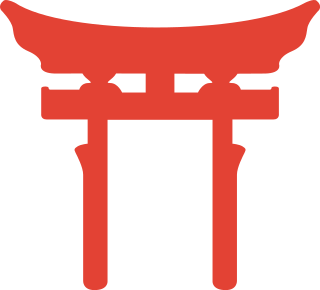
The Kofun period is an era in the history of Japan from about 300 to 538 AD, following the Yayoi period. The Kofun and the subsequent Asuka periods are sometimes collectively called the Yamato period. This period is the earliest era of recorded history in Japan, but studies depend heavily on archaeology since the chronology of historical sources tends to be distorted.

Genkurō (源九郎) is a shape-changing kitsune (fox-spirit) character who features prominently in the famous jōruri and kabuki play Yoshitsune Senbon Zakura.
Chūshingura is the title given to fictionalized accounts in Japanese literature, theatre, and film that relate to the historical incident involving the forty-seven rōnin and their mission to avenge the death of their master, Asano Naganori. Including the early Kanadehon Chūshingura (仮名手本忠臣蔵), the story has been told in kabuki, bunraku, stage plays, films, novels, television shows and other media. With ten different television productions in the years 1997–2007 alone, Chūshingura ranks among the most familiar of all historical stories in Japan.

Yoshitsune Senbon Zakura (義経千本桜), or Yoshitsune and the Thousand Cherry Trees, is a Japanese play, one of the three most popular and famous in the Kabuki repertoire. Originally written in 1747 for the jōruri puppet theater by Takeda Izumo II, Miyoshi Shōraku and Namiki Senryū I, it was adapted to kabuki the following year.

The Suwa clan, also known as the Miwa clan was a Japanese clan hailing from the area encompassing Lake Suwa in Shinano Province. Originally a family of priests who served at the Suwa Grand Shrine, by the Kamakura period it thrived as a prominent warrior clan with close ties to the shogunate.
Kōwakamai (幸若舞) is a Japanese recitative dance, originating in the 15th century and popular during the Sengoku and early Edo periods. Although kōwakamai has dance and musical components, scholars consider its textual component as an independent literary genre.

The Sora Tabi Nikki was the memorandum of Kawai Sora in 1689 and 1691 when he accompanied Matsuo Bashō, on his noted journeys. By the time it was re-discovered in 1943, the presence of this diary had been doubted. This diary has proven indispensable in the study of Oku no Hosomichi by Matsuo Bashō.
Atmospheric ghost lights are lights that appear in the atmosphere without an obvious cause. Examples include the onibi, hitodama and will-o'-wisp. They are often seen in humid climates.

Moon Saga - Mysteries of Yoshitsune I&II is a theatre stage play written, composed and directed by Japanese recording artist Gackt. The show is notable for the first major use of projection mapping in theatre stage play. The original soundtrack was released on October 1, 2014 and compiles music from the theatre stage play. It consists of two music CDs for each chapter, the first of which was performed in 2012, while the second was performed in 2014.
Kibi dango is Japanese dumpling made from the meal or flour of the kibi grain. The treat was used by folktale-hero Momotarō to recruit his three beastly retainers, in the commonly known version of the tale.

Takeminakata-no-Kami (建御名方神) or Takeminakata-no-Mikoto (建御名方命), also known as Minakatatomi-no-Kami (南方刀美神) or Takeminakatatomi-no-Mikoto (建御名方富命) is the name of one of the two principal deities of Suwa Grand Shrine in Nagano Prefecture. Also known under the epithet Suwa Myōjin (諏訪明神) or Suwa Daimyōjin (諏訪大明神), he is considered to be a god of wind, water and agriculture, as well as a patron of hunting and warfare, in which capacity he enjoyed a particularly fervent cult from various samurai clans during the medieval period such as the Hōjō or the Takeda. The deity was also held to be the original ancestor of certain families who once served at the shrine as priests, foremost among them being the Suwa clan, the high priests of the Upper Shrine of Suwa who were also revered as the living incarnations of the god.

Ueda Sōko-ryū (上田宗箇流) is a cultural aesthetic practice, or tradition, of Japanese tea ceremony that originated within the samurai class of feudal Japan. The tradition is commonly called the Ueda Sōko Ryū or Ueda Ryū. The founder from whom the tradition takes its name was Sengoku period warlord Ueda Sōko. The customs, etiquette and values of the samurai are woven throughout all aspects of the tradition's practice of chanoyu, a practice that has continued unbroken for over 400 years.

Yuriwaka is the titular hero of a Japanese tale of vengeance. Yuriwaka, famed for his enormous iron bow, is victorious as a general against the Mongolian forces, but is abandoned on an island by a traitorous subordinate (Beppu) who usurps his governorship. Yuriwaka's hawk (Midori-maru) couriers back a letter to his wife, who prays to the shrine, and through divine intervention, Yuriwaka returns to the province of his governorship. He withholds his identity until the opportune moment to prove his prowess on his iron bow, and avenges himself on the traitor.
Medieval Japanese literature, written during the Kamakura, Nanbokuchō and Muromachi periods, was written during a transitional period for Japanese literature. Kyoto ceased being the sole literary centre as important writers and readerships appeared throughout the country, and a wider variety of genres and literary forms developed accordingly, such as the gunki monogatari and otogi-zōshi prose narratives, and renga linked verse.















